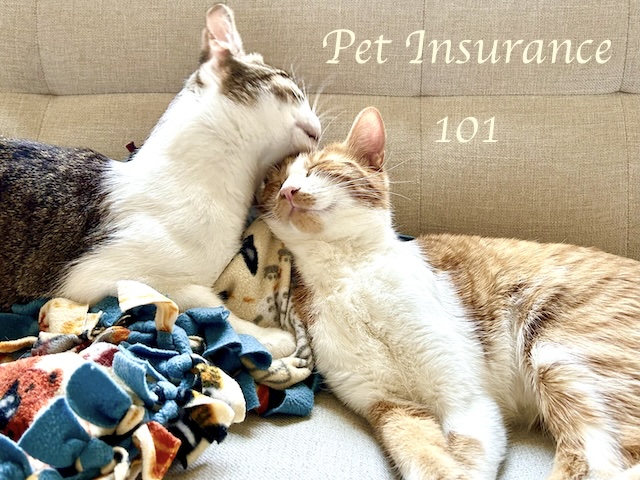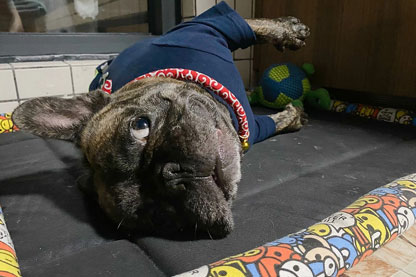
![[US Pet Insurance] The 10 most common basic terms and concepts 1 Introduction to US Pet Insurance: Cover Photo](https://joyceinthebay.com/wp-content/uploads/2024/02/insurance-1-13.jpg)
Everyone knows that healthcare in the United States is expensive, but few people know that veterinary care can often be even more expensive than human care. Buying the right insurance at the right time allows you to choose the best care without worry when your pet becomes ill. But what is the right time? What is the right insurance? And why is insurance so important?
To make it easier for beginners to read, this article will try to introduce the basic concepts of pet insurance in the United States in a concise and straightforward manner. If you have any thoughts, please leave a comment to add to it. I wish everyone’s insurance will bring peace of mind and never need it.
*Disclaimer: All insurance-related content on this blog is solely for experience sharing and has no legal validity. It does not constitute professional advice. If you have any questions, please refer to the policy details and the insurance company's response.
- What is pet insurance?
- 💡 Insurance
- 💡 Insurance add-on options
- 💡 Wellness Plan for Hospitals/Stores
- Pet Insurance in the United States: Basic Concepts
- 💡 Policy
- 💡 Coverage
- 💡 Waiting Period
- 💡 Pre-existing Condition
- 💡Annual Limit annual limit
- 💡 Deductible
- 💡 Reimbursement Rate
- 💡 Submit a Claim
- 💡 Premium
- Is insurance necessary?
- How to choose pet insurance?
What is pet insurance?
💡 Insurance
Pet insurance in the United States covers medical expenses incurred by pets due to unexpected accidents and illnesses . The insurance company, according to the policy, will reimburse a percentage of the costs . Pricing, age limits, and coverage vary from insurance company to insurance company. Furthermore, most preventive medical procedures , such as vaccinations, deworming, sterilization, and dental cleanings, are not covered because they are not caused by accidents or illnesses.
🍀Insurance : Pays for medical expenses incurred due to “sudden accidents or illnesses”.
💡 Insurance add-on options
While insurance policies don’t typically cover preventative measures, most insurance companies offer a wellness add -on option, allowing you to choose whether to add these measures when purchasing your policy. For example, Figo’s Wellness Plus (pictured below) covers a portion of the costs of preventative measures like health checkups, vaccinations, and deworming.
![[US Pet Insurance] The 10 Most Common Basic Terms & Concepts Introduction 2 Basic Introduction to US Pet Insurance: Insurance Add-on Options - Figo](https://joyceinthebay.com/wp-content/uploads/2024/02/insurance-1-2.jpg)
Insurance companies can distinguish, define and name these options on their own. The only thing that remains unchanged is that these are services that can be purchased “after buying insurance” and cannot be purchased separately.
🍀 Insurance add-on option : Provided by the insurance company, based on the content of the original insurance, allowing the policyholder to choose whether to purchase an additional policy to expand the coverage.
💡 Wellness Plan for Hospitals/Stores
Some veterinary hospital chains and pet supply stores, such as Banfield and Petco, offer their own Wellness Plans. Banfield’s Kitten Wellness Plan, for example, only covers visit fees, sterilization, vaccinations, and disease testing. It doesn’t cover accidental or medical expenses, making it not considered insurance. Furthermore, because it’s Banfield’s own plan, it’s only valid at Banfield and not at other hospitals.
![[US Pet Insurance] The 10 Most Common Basic Terms & Concepts Introduction 3 A Wellness Plan Isn't Pet Insurance: Take the Banfield Kitten Wellness Plan as an Example](https://joyceinthebay.com/wp-content/uploads/2024/02/insurance-1-4.jpg)
🍀Wellness Plan from Hospital/Store : A medical package purchased directly from a hospital or store, the specific contents of which are determined by the seller.
Pet Insurance in the United States: Basic Concepts
After understanding the difference between insurance and wellness plan, let’s learn some basic insurance concepts!
![[US Pet Insurance] The 10 Most Common Basic Terms & Concepts 4 US Pet Insurance, US Pet Insurance Introduction - Joyce's American Story](https://joyceinthebay.com/wp-content/uploads/2024/03/insurance-2-19.jpg)
💡 Policy
The policy is the foundation of insurance , documenting all regulations and precautions, including the rules for enrolling, definitions of terms, coverage, claims settlement procedures, and contract termination procedures . In simpler terms, the policy details the identity of the policyholder and the insured, the premium amount, payment methods, the scope of claims and non-claims, the validity period of the policy, how to file a claim, and how to modify the contract.
Potential policyholders who haven’t yet purchased insurance won’t have a formal policy, but they can still refer to the sample policy provided by the insurance company . Search “insurance name + sample policy” on Google to find it. In the US, policy details can vary slightly due to state regulations. If you encounter any questions, directly contacting customer service is the easiest and quickest way. Remember to keep written records of any interactions with the insurance company.
![[US Pet Insurance] The 10 most common basic terms and concepts 5 Basic Introduction to US Pet Insurance: Policy & Sample Policy](https://joyceinthebay.com/wp-content/uploads/2024/02/insurance-1-5.jpg)
🍀The insurance policy is the basis of insurance, be sure to read it carefully before purchasing!
💡 Coverage
The details of your insurance policy regarding what’s covered and what’s not are called coverage. This information might be called something like “Coverage & Exclusions,” “What is Covered & What is Not Covered,” or something similar. Only illnesses and accidents that fall within the coverage are eligible for insurance claims.
💡 Waiting Period
US pet insurance policies typically have a 14-day waiting period. Some companies differentiate between illness and accident waiting periods, or set longer waiting periods for specific conditions (usually orthopedic conditions). Regardless of the waiting period, you must wait until the waiting period ends before filing a claim.
💡 Pre-existing Condition
Any illness or symptoms that develop before the waiting period is highly likely to be classified as a pre-existing condition . To prevent owners from purchasing insurance in a hurry after discovering they can’t afford medical expenses, over 99% of insurance companies don’t cover pre-existing conditions .
In most cases, the condition that determines whether a disease/symptom is pre-existing is the time when the disease/symptom was first discovered , not the actual date of seeing a doctor.
For example, let’s say the policy’s effective date is January 1, 2024. The owner noticed their cat had a runny nose on December 31, 2023, and they visited the veterinarian on January 2, 2024. The veterinarian noted the runny nose on December 31. Because the runny nose (December 31) occurred before the effective date (January 1), even though the visit to the veterinarian (January 2) occurred after the effective date, the runny nose and any subsequent diagnosis are likely pre-existing conditions and are therefore not covered.
![[US Pet Insurance] The 10 Most Common Basic Terms & Concepts Introduction 6 Basic Introduction to US Pet Insurance: Pre-existing conditions, past medical history](https://joyceinthebay.com/wp-content/uploads/2024/02/insurance-1-6.jpg)
Some insurance companies categorize pre-existing conditions as curable or incurable . For non-curable pre-existing conditions, even if symptoms are controlled, insurance will not cover them, regardless of how long they are controlled. For curable pre-existing conditions, there’s a chance that after a certain number of days, they’ll be considered cured and covered again.
🍀 AKC, PetPartners, and Felix will re-insure certain pre-existing conditions after 365 consecutive days of coverage.
🍀How to avoid pre-existing conditions: Buy insurance when your medical records are clean!
💡Annual Limit annual limit
The annual limit is the maximum amount the insurance company will pay out during each policy period . If the limit is $4,000, after the insurance company pays out $4,000, you will not be able to claim any medical expenses incurred until the next renewal. Please highlight the following:
For most plans, the annual cap can only be lowered , not raised again. If you want to increase your cap , you'll likely have to renew your policy , recalculate your waiting period, and all previous medical records will become pre-existing conditions.
So, don’t be tempted to buy a lower limit now and increase it as your pet ages. No one knows if any noncurable pre-existing conditions will arise in the meantime. The safest option is to go straight for the Unlimited Annual Limit when your pet’s medical records are clean !
![[US Pet Insurance] The 10 Most Common Basic Terms & Concepts 7 Basic Introduction to US Pet Insurance: Annual Limit Can Only Be Lowered, Not Increased](https://joyceinthebay.com/wp-content/uploads/2024/02/insurance-1-7.jpg)
💡 Deductible
The deductible is the amount you must pay before your insurance policy begins to pay claims . Only amounts covered by your insurance policy are counted towards your deductible.
What does it mean?
For example, let’s say Riley doesn’t have any symptoms. I take her for her annual checkup and one vaccination, totaling $145. Riley’s remaining deductible is $500, and her insurance doesn’t cover the checkup and vaccinations. So, even if I pay the $145 bill to the insurance company, since it wasn’t covered in the first place , Riley’s remaining deductible will still be $500 minus $0 = $500 . It won’t decrease!
For example, Shuai Shuai visits a doctor for a cold and is prescribed antibiotics, costing 130 yuan. Shuai Shuai currently has a remaining deductible of 500 yuan. His insurance covers both outpatient visits and medical expenses, and since the cold wasn’t a pre-existing condition, the waiting period has already expired. In this case, the 130 yuan cost of this visit, once approved by the insurance company , will be counted toward his deductible. Therefore, Shuai Shuai’s remaining deductible is 500 – 130 = 370 yuan .
🍀 Insurance will only start paying out after the deductible is met.
🍀The higher the deductible , the more expenses the owner has to bear first, and the lower the premium will usually be .
![[US Pet Insurance] The 10 Most Common Basic Terms & Concepts 8 Introduction to the Basics of US Pet Insurance: Deductible Algorithm](https://joyceinthebay.com/wp-content/uploads/2024/02/insurance-1-12.jpg)
💡 Reimbursement Rate
The actual amount you can get for each claim application depends on the reimbursement rate you chose .
Let’s say I have a $680 bill with a 90% reimbursement ratio. My deductible has been met, but I haven’t reached the annual limit. After review, the insurance company agrees that the $680 was used for all purposes covered by insurance . Then, my claim is $680 * 90% = $612 . My actual claim goes from $680 to $68.
If the bill amount is $2000 , the insurance will cover $2000*90%=1800 yuan, and the actual amount you have to pay is 2000*10%= 200 yuan .
🍀The higher the compensation ratio , the greater the burden on the insurance company and the higher the premium .
💡 Submit a Claim
It has been mentioned before that you can only get the money after ” Submit a Claim “, so how do you apply?
Currently, most pet insurance policies in the United States adopt a pay-first-then-claim model. The specific process is: see a veterinarian – pay in full – file a claim – review – and receive compensation. When applying for coverage, you must attach medical records (including doctor’s notes) and receipts , both of which must be obtained from the veterinarian.
![[US Pet Insurance] The 10 Most Common Basic Terms & Concepts 9 Introduction to the Basics of US Pet Insurance: Claim Processing](https://joyceinthebay.com/wp-content/uploads/2024/02/insurance-1-10.jpg)
🍀 If you are not satisfied with the review results, you can appeal to the insurance company within the time limit .
💡 Premium
Premiums are the cost of purchasing insurance . Generally speaking, factors influencing premiums include: type of insurance, policy details, age, region, and whether or not a person has been sterilized . The annual limit, deductible, and compensation ratio also affect premium calculations. Insurance prices will eventually increase.
Is insurance necessary?
Some people might think, “If you don’t use your insurance, you’re losing money!” Buying insurance is such a hassle, it’s better to save the money yourself.
In Northern California, a typical veterinary exam fee— the basic cost of speaking with the doctor and physical examination—ranges between $50 and $100. X-rays, ultrasounds, and blood tests run about $200 to $500, and a shot of antibiotics costs $50 to $100. For an emergency visit, like the one we went to at Medvet Mountain View , the outpatient fee is $195. Surgery, hospitalization, MRIs, specialist referrals, and more can add up to a single bill exceeding a thousand dollars.
Since I’ve had cats, every time I’ve taken them to the vet, the bill has never been less than 100 yuan. In various cat-raising groups, I often see stories of people racking up thousands or even tens of thousands of yuan in medical bills due to hospitalizations, surgeries, and serious illnesses. The sudden financial and psychological pressure can often force owners to abandon their pets or seek euthanasia.
![[US Pet Insurance] The 10 most common basic terms and concepts Introduction to the basics of pet insurance in the United States: The importance of insurance](https://joyceinthebay.com/wp-content/uploads/2024/02/insurance-1-11.jpg)
If you could always have at least $30,000 to $50,000 in a pet medical fund ready to cover any shortfalls, then insurance might not be necessary. I don’t have that much spare cash, so I definitely buy insurance. I also don’t believe the saying “if you don’t use your insurance, you lose it” is true. Insurance covers the unexpected, covers unexpected major illnesses, and provides the confidence to choose the best solution no matter the situation. No one really wants to recoup their investment. If your pet doesn’t use insurance, go hug them and tell them what a great job they have!
How to choose pet insurance?
This article is really long and contains a lot of information. Congratulations on reading this far. Thank you for your hard work. Take ten seconds to applaud yourself.
![[US Pet Insurance] The 10 Most Common Basic Terms & Concepts Introduction 11 Introduction to the basics of pet insurance in the United States: Ending photo](https://joyceinthebay.com/wp-content/uploads/2024/02/insurance-1-14.jpg)
Now that you understand the basics of insurance, the next step is actually purchasing it! Besides the concepts mentioned in this article, what other considerations are there when buying insurance? What restrictions might you encounter? What does a sample policy actually look like? We’ll cover all of this in the next article!


